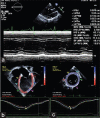Radiofrequency ablation for fascicular ventricular tachycardia causing tachycardiomyopathy and brief literature review
- PMID: 33679072
- PMCID: PMC7918018
- DOI: 10.4103/apc.APC_73_20
Radiofrequency ablation for fascicular ventricular tachycardia causing tachycardiomyopathy and brief literature review
Abstract
A 10-years-old boy presented with a history of effort intolerance and palpitations for 4 months. His electrocardiogram showed wide complex tachycardia suggestive of fascicular ventricular tachycardia (VT). The echocardiogram showed moderate-to-severe left ventricular systolic dysfunction without any structural lesion. The tachycardia was unresponsive to adenosine and direct current cardioversion. It responded to oral verapamil. The electrophysiology study confirmed the tachycardia as left posterior fascicular VT. The tachycardia was successfully ablated guided by Purkinje potential on three-dimensional mappings. He showed improvement in ventricular functions before discharge. He is doing well on short-term follow-up.
Keywords: Fascicular ventricular tachycardia; radiofrequency ablation; tachycardiomyopathy.
Copyright: © 2020 Annals of Pediatric Cardiology.
Conflict of interest statement
There are no conflicts of interest.
Figures








Similar articles
-
Fascicular ventricular tachycardia: experience with radiofrequency ablation.Rev Port Cardiol. 2006 May;25(5):485-97. Rev Port Cardiol. 2006. PMID: 16910156 English, Portuguese.
-
Left posterior fascicular block: a new endpoint of ablation for verapamil-sensitive idiopathic ventricular tachycardia.Chin Med J (Engl). 2006 Mar 5;119(5):367-72. Chin Med J (Engl). 2006. PMID: 16542578
-
Verapamil-sensitive left anterior fascicular ventricular tachycardia: results of radiofrequency ablation in six patients.J Cardiovasc Electrophysiol. 1998 Dec;9(12):1269-78. doi: 10.1111/j.1540-8167.1998.tb00102.x. J Cardiovasc Electrophysiol. 1998. PMID: 9869526
-
Idiopathic left ventricular tachycardia: assessment and treatment.Card Electrophysiol Rev. 2002 Dec;6(4):448-57. doi: 10.1023/a:1021100828459. Card Electrophysiol Rev. 2002. PMID: 12438827 Review.
-
Purkinje-related arrhythmias part I: monomorphic ventricular tachycardias.Pacing Clin Electrophysiol. 2011 May;34(5):624-50. doi: 10.1111/j.1540-8159.2011.03044.x. Epub 2011 Mar 16. Pacing Clin Electrophysiol. 2011. PMID: 21410719 Review.
Cited by
-
Tachycardia-Induced Cardiomyopathy: A Case Series and a Literature Review.CJC Pediatr Congenit Heart Dis. 2024 Nov 2;3(6):272-284. doi: 10.1016/j.cjcpc.2024.10.007. eCollection 2024 Dec. CJC Pediatr Congenit Heart Dis. 2024. PMID: 39959626 Free PMC article. Review.
References
-
- Fenelon G, Wijns W, Andries E, Brugada P. Tachycardiomyopathy: Mechanisms and clinical implications. Pacing Clin Electrophysiol. 1996;19:95–106. - PubMed
-
- Moore JP, Patel PA, Shannon KM, Albers EL, Salerno JC, Stein MA, et al. Predictors of myocardial recovery in pediatric tachycardia-induced cardiomyopathy. Heart Rhythm. 2014;11:1163–9. - PubMed
-
- Gillette PC, Garson A., Jr Electrophysiologic and pharmacologic characteristics of automatic ectopic atrial tachycardia. Circulation. 1977;56:571–5. - PubMed
-
- Massin MM, Benatar A, Rondia G. Epidemiology and outcome of tachyarrhythmias in tertiary pediatric cardiac centers. Cardiology. 2008;111:191–6. - PubMed
Publication types
LinkOut - more resources
Full Text Sources
Other Literature Sources
